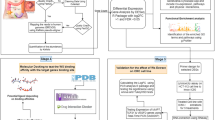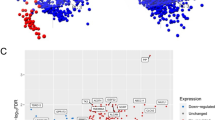Abstract
Background
Esophageal squamous cell carcinoma (ESCC) is a kind of cancer with heterogeneous biological characteristics, which is affected by a complex network of gene interactions. Identification of molecular biomarkers paves the way for individualized therapy based on gene expression profiles, which can overcome the heterogeneity of ESCC.
Methods
In this study, GSE20347, GSE23400 and GSE45670 datasets were retrieved from Gene Expression Omnibus (GEO) database, and the overlapping differentially expressed genes (DEGs) in three datasets were screened. Then the overlapping DEGs function was annotated by Kyoto Encyclopedia of Genes and Genomes (KEGG) pathway-enrichment analysis. The prognostic value of the top five KEGG pathway-related genes were further validated in The Cancer Genome Atlas (TCGA) database. After extensive statistical analysis, four genes (CDC25B, CXCL8, FZD6 and MCM4) were identified as potential prognostic markers. Among the four candidate genes, the prognostic value of FZD6 in ESCC patients has not been evaluated. Therefore, we finally used immunohistochemistry method to evaluate the effect of FZD6 on the prognosis of patients with ESCC. Additionally, we detected the expression level of FZD6 in ESCC cell line and normal esophageal epithelial cell line, and observed the cell viability of ESCC cell line after FZD6 knockdown.
Results
The results showed that the overexpression of FZD6 predicted poor overall survival (OS) (P = 0.005) and progression-free survival (PFS) (P = 0.004) in ESCC patients. COX regression analysis showed that N stage (P = 0.026) and FZD6 expression level (P = 0.001) were independent prognostic factors of OS for ESCC patients. Furthermore, compared with normal esophageal epithelial cell line, the up-regulation of FZD6 was detected in ESCC cell line. Knockdown of FZD6 could significantly inhibit the proliferation of ESCC cells (P < 0.001).
Conclusion
CDC25B, CXCL8, FZD6 and MCM4 were screened as candidate genes for prognosis assessment of patients with ESCC. The prognostic role of FZD6 in ESCC patients was confirmed in current study.




Similar content being viewed by others
References
Bray F, Ferlay J, Soerjomataram I, Siegel RL, Torre LA, Jemal A. Global cancer statistics 2018: GLOBOCAN estimates of incidence and mortality worldwide for 36 cancers in 185 countries. CA Cancer J Clin. 2018;68(6):394–424.
Lagergren J, Smyth E, Cunningham D, Lagergren P. Oesophageal cancer. Lancet. 2017;390(10110):2383–96.
Herskovic A, Russell W, Liptay M, Fidler MJ, Al-Sarraf M. Esophageal carcinoma advances in treatment results for locally advanced disease: review. Ann Oncol. 2012;23(5):1095–103.
Paulson TG. Studying cancer evolution in Barrett's esophagus and esophageal adenocarcinoma. Adv Exp Med Biol. 2016;908:213–36.
Tochigi T, Shuto K, Kono T, Ohira G, Tohma T, Gunji H, et al. Heterogeneity of glucose metabolism in esophageal cancer measured by fractal analysis of fluorodeoxyglucose positron emission tomography image: correlation between metabolic heterogeneity and survival. Dig Surg. 2017;34(3):186–91.
Lin DC, Wang MR, Koeffler HP. Genomic and epigenomic aberrations in esophageal squamous cell carcinoma and implications for patients. Gastroenterology. 2018;154(2):374–89.
Greenawalt DM, Duong C, Smyth GK, Ciavarella ML, Thompson NJ, Tiang T, et al. Gene expression profiling of esophageal cancer: comparative analysis of Barrett's esophagus, adenocarcinoma, and squamous cell carcinoma. Int J Cancer. 2007;120(9):1914–21.
Tamoto E, Tada M, Murakawa K, Takada M, Shindo G, Teramoto K, et al. Gene-expression profile changes correlated with tumor progression and lymph node metastasis in esophageal cancer. Clin Cancer Res. 2004;10(11):3629–38.
He Y, Liu J, Zhao Z, Zhao H. Bioinformatics analysis of gene expression profiles of esophageal squamous cell carcinoma. Dis Esophagus. 2017;30(5):1–8.
Harada K, Mizrak Kaya D, Shimodaira Y, Song S, Baba H, Ajani JA. Translating genomic profiling to gastrointestinal cancer treatment. Future Oncol. 2017;13(10):919–34.
Hu N, Clifford RJ, Yang HH, Wang C, Goldstein AM, Ding T, et al. Genome wide analysis of DNA copy number neutral loss of heterozygosity (CNNLOH) and its relation to gene expression in esophageal squamous cell carcinoma. BMC Genom. 2010;11:576.
Su H, Hu N, Yang HH, Wang C, Takikita M, Wang QH, et al. Global gene expression profiling and validation in esophageal squamous cell carcinoma and its association with clinical phenotypes. Clin Cancer Res. 2011;17(9):2955–66.
Wen J, Yang H, Liu MZ, Luo KJ, Liu H, Hu Y, et al. Gene expression analysis of pretreatment biopsies predicts the pathological response of esophageal squamous cell carcinomas to neo-chemoradiotherapy. Ann Oncol. 2014;25(9):1769–74.
Feng Y, Song LB, Guo BH, Liao WT, Li MZ, Liu WL, et al. Expression and significance of Bmi-1 in breast cancer. Ai Zheng. 2007;26(2):154–7.
Shou JZ, Hu N, Takikita M, Roth MJ, Johnson LL, Giffen C, et al. Overexpression of CDC25B and LAMC2 mRNA and protein in esophageal squamous cell carcinomas and premalignant lesions in subjects from a high-risk population in China. Cancer Epidemiol Biomark Prev. 2008;17(6):1424–35.
Hosono M, Koma YI, Takase N, Urakawa N, Higashino N, Suemune K, et al. CXCL8 derived from tumor-associated macrophages and esophageal squamous cell carcinomas contributes to tumor progression by promoting migration and invasion of cancer cells. Oncotarget. 2017;8(62):106071–88.
Ogura M, Takeuchi H, Kawakubo H, Nishi T, Fukuda K, Nakamura R, et al. Clinical significance of CXCL-8/CXCR-2 network in esophageal squamous cell carcinoma. Surgery. 2013;154(3):512–20.
Huang XP, Rong TH, Wu QL, Fu JH, Yang H, Zhao JM, et al. MCM4 expression in esophageal cancer from southern China and its clinical significance. J Cancer Res Clin Oncol. 2005;131(10):677–82.
Yamashita S, Kishino T, Takahashi T, Shimazu T, Charvat H, Kakugawa Y, et al. Genetic and epigenetic alterations in normal tissues have differential impacts on cancer risk among tissues. Proc Natl Acad Sci USA. 2018;115(6):1328–33.
Tokuhara M, Hirai M, Atomi Y, Terada M, Katoh M. Molecular cloning of human Frizzled-6. Biochem Biophys Res Commun. 1998;243(2):622–7.
Burstyn-Cohen T, Stanleigh J, Sela-Donenfeld D, Kalcheim C. Canonical Wnt activity regulates trunk neural crest delamination linking BMP/noggin signaling with G1/S transition. Development. 2004;131(21):5327–39.
Lyuksyutova AI, Lu CC, Milanesio N, King LA, Guo N, Wang Y, et al. Anterior-posterior guidance of commissural axons by Wnt-frizzled signaling. Science. 2003;302(5652):1984–8.
Reya T, Clevers H. Wnt signalling in stem cells and cancer. Nature. 2005;434(7035):843–50.
Krutzfeldt J, Rosch N, Hausser J, Manoharan M, Zavolan M, Stoffel M. MicroRNA-194 is a target of transcription factor 1 (Tcf1, HNF1alpha) in adult liver and controls expression of frizzled-6. Hepatology. 2012;55(1):98–107.
Corda G, Sala G, Lattanzio R, Iezzi M, Sallese M, Fragassi G, et al. Functional and prognostic significance of the genomic amplification of frizzled 6 (FZD6) in breast cancer. J Pathol. 2017;241(3):350–61.
Kim BK, Yoo HI, Kim I, Park J, Kim YS. FZD6 expression is negatively regulated by miR-199a-5p in human colorectal cancer. BMB Rep. 2015;48(6):360–6.
Wu QL, Zierold C, Ranheim EA. Dysregulation of Frizzled 6 is a critical component of B-cell leukemogenesis in a mouse model of chronic lymphocytic leukemia. Blood. 2009;113(13):3031–9.
Han K, Lang T, Zhang Z, Zhang Y, Sun Y, Shen Z, et al. Luteolin attenuates Wnt signaling via upregulation of FZD6 to suppress prostate cancer stemness revealed by comparative proteomics. Sci Rep. 2018;8(1):8537.
Huang T, Alvarez AA, Pangeni RP, Horbinski CM, Lu S, Kim SH, et al. A regulatory circuit of miR-125b/miR-20b and Wnt signalling controls glioblastoma phenotypes through FZD6-modulated pathways. Nat Commun. 2016;7:12885.
Yan J, Liu T, Zhou X, Dang Y, Yin C, Zhang G. FZD6, targeted by miR-21, represses gastric cancer cell proliferation and migration via activating non-canonical wnt pathway. Am J Transl Res. 2016;8(5):2354–64.
Cantilena S, Pastorino F, Pezzolo A, Chayka O, Pistoia V, Ponzoni M, et al. Frizzled receptor 6 marks rare, highly tumourigenic stem-like cells in mouse and human neuroblastomas. Oncotarget. 2011;2(12):976–83.
Funding
This work was supported by the National Natural Science Foundation of China (81502094) and First-Class Discipline Construction Founded Project of NingXia Medical University and the School of Clinical Medicine (NXYLXK2017A05).
Author information
Authors and Affiliations
Corresponding author
Ethics declarations
Conflict of interest
The authors have declared that no competing interests exist.
Ethical approval
The study was reviewed and approved by the Ethics Committee of the General Hospital of Ningxia Medical University. All patients provided written informed consent, and the study was conducted in accordance with the Declaration of Helsinki.
Informed consent
Informed consent is not required for this type of study.
Additional information
Publisher's Note
Springer Nature remains neutral with regard to jurisdictional claims in published maps and institutional affiliations.
Electronic supplementary material
Below is the link to the electronic supplementary material.
Rights and permissions
About this article
Cite this article
Zhang, J., Wang, JL., Zhang, CY. et al. The prognostic role of FZD6 in esophageal squamous cell carcinoma patients. Clin Transl Oncol 22, 1172–1179 (2020). https://doi.org/10.1007/s12094-019-02243-3
Received:
Accepted:
Published:
Issue Date:
DOI: https://doi.org/10.1007/s12094-019-02243-3




